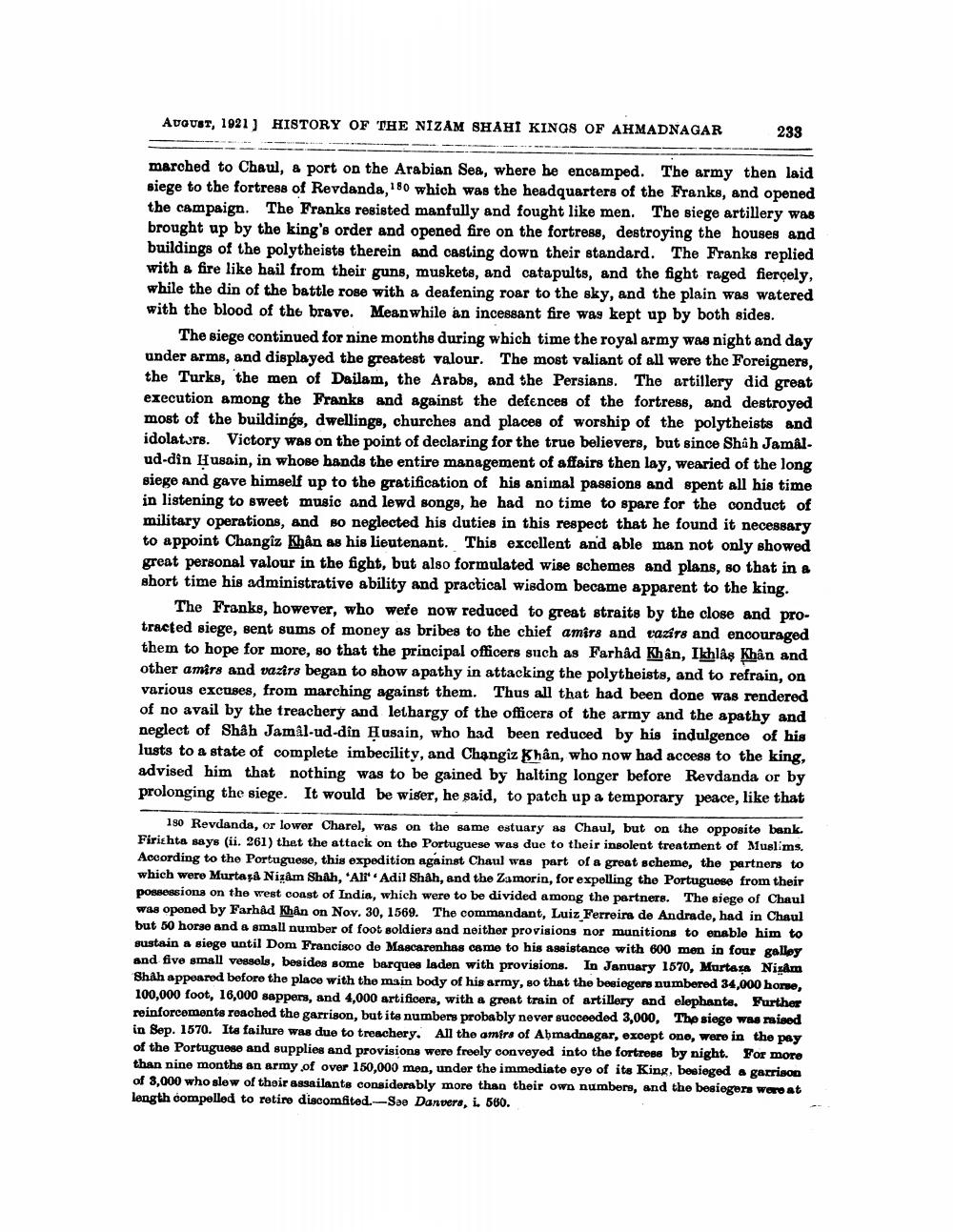________________
AUGUST, 1921] HISTORY OF THE NIZAM SHAHI KINGS OF AHMADNAGAR
marched to Chaul, a port on the Arabian Sea, where he encamped. The army then laid siege to the fortress of Revdanda, 180 which was the headquarters of the Franks, and opened the campaign. The Franks resisted manfully and fought like men. The siege artillery was brought up by the king's order and opened fire on the fortress, destroying the houses and buildings of the polytheists therein and casting down their standard. The Franks replied with a fire like hail from their guns, muskets, and catapults, and the fight raged fiercely, while the din of the battle rose with a deafening roar to the sky, and the plain was watered with the blood of the brave. Meanwhile an incessant fire was kept up by both sides.
233
The siege continued for nine months during which time the royal army was night and day under arms, and displayed the greatest valour. The most valiant of all were the Foreigners, the Turks, the men of Dailam, the Arabs, and the Persians. The artillery did great execution among the Franks and against the defences of the fortress, and destroyed most of the buildings, dwellings, churches and places of worship of the polytheists and idolators. Victory was on the point of declaring for the true believers, but since Shah Jamâlud-din Husain, in whose hands the entire management of affairs then lay, wearied of the long siege and gave himself up to the gratification of his animal passions and spent all his time in listening to sweet music and lewd songs, he had no time to spare for the conduct of military operations, and so neglected his duties in this respect that he found it necessary to appoint Changîz Khân as his lieutenant. This excellent and able man not only showed great personal valour in the fight, but also formulated wise schemes and plans, so that in a short time his administrative ability and practical wisdom became apparent to the king.
The Franks, however, who were now reduced to great straits by the close and protracted siege, sent sums of money as bribes to the chief amirs and vazirs and encouraged them to hope for more, so that the principal officers such as Farhad Khân, Ikhlas Khân and other amirs and vazirs began to show apathy in attacking the polytheists, and to refrain, on various excuses, from marching against them. Thus all that had been done was rendered of no avail by the treachery and lethargy of the officers of the army and the apathy and neglect of Shâh Jamâl-ud-din Husain, who had been reduced by his indulgence of his lusts to a state of complete imbecility, and Changiz Khân, who now had access to the king, advised him that nothing was to be gained by halting longer before Revdanda or by prolonging the siege. It would be wiser, he said, to patch up a temporary peace, like that
180 Revdanda, or lower Charel, was on the same estuary as Chaul, but on the opposite bank. Firishta says (ii. 261) that the attack on the Portuguese was due to their insolent treatment of Muslims. According to the Portuguese, this expedition against Chaul was part of a great scheme, the partners to which were Murtaza Nizam Shah, 'All Adil Shah, and the Zamorin, for expelling the Portuguese from their possessions on the west coast of India, which were to be divided among the partners. The siege of Chaul was opened by Farhad Khan on Nov. 30, 1569. The commandant, Luiz Ferreira de Andrade, had in Chaul but 50 horse and a small number of foot soldiers and neither provisions nor munitions to enable him to sustain a siege until Dom Francisco de Mascarenhas came to his assistance with 600 men in four galley and five small vessels, besides some barques laden with provisions. In January 1570, Murtaza Nizam Shah appeared before the place with the main body of his army, so that the besiegers numbered 34,000 horse, 100,000 foot, 16,000 sappers, and 4,000 artificers, with a great train of artillery and elephants. Further reinforcements reached the garrison, but its numbers probably never succeeded 3,000, The siege was raised in Sep. 1570. Its failure was due to treachery. All the amirs of Ahmadnagar, except one, were in the pay of the Portuguese and supplies and provisions were freely conveyed into the fortress by night. For more than nine months an army of over 150,000 men, under the immediate eye of its King, besieged a garrison of 3,000 who slew of their assailants considerably more than their own numbers, and the besiegers were at length compelled to retire discomfited.-See Danvers, i. 560.




